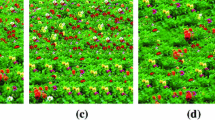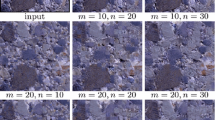Abstract
An algorithm for synthesizing color textures from a small set of parameters is presented in this paper. The synthesis algorithm is based on the 2-D moving average model, and realistic textures resembling many real textures can be synthesized using this algorithm. A maximum likelihood estimation algorithm to estimate parameters from a sample texture is also presented. By combining the estimation and synthesis algorithms, a color texture can be synthesized from a sample texture without human intervention. Using the estimated parameters, a texture larger than the original image can be synthesized from a small texture sample. The synthesis algorithm does not require an expensive iterative algorithm, and the quality of synthesized textures may be acceptable for many multimedia applications. In the experiment, various textures suitable for multimedia applications are synthesized from parameters estimated from real textures.
Similar content being viewed by others
References
M.M. Blattner and R.B. Dannenberg, Multimedia Interface Design, ACM Press, 1992.
D.R. Brillinger, Time Series, Data Analysis and Theory, Expanded Edition, Holden Day, 1981.
P. Brodatz, Textures: A Photographic Album for Artist and Designers, Dover Publication: New York, 1966
J.F.K. Buford, Multimedia Systems, ACM Press, 1994.
D. Cano and T.H. Minh, “Texture synthesis using hierarchical linear transform,” Signal Processing, Vol. 15, pp. 131–148, 1988.
R. Chellappa and R.L. Kashyap, “Texture synthesis using 2-D non-causal autoregressive models,” IEEE Trans. on Acoustics, Speech and Signal Processing, Vol. 33, No. 1, pp. 194–203, 1985.
M.L. Dai and K. Ozawa, “Texture synthesis by l-systems,” Image and Vision Computing, Vol. 15, pp. 197–204, 1997.
J.S. DeBonet, “Multiresolution sampling procedure for analysis and synthesis of texture images,” in Computer Graphics: Proceedings of SIGGRAPH '97, 1997, pp. 361-368.
N. Dodd, “Multispectral texture synthesis using fractal concepts,” IEEE Trans. on Pattern Anal. and Machine Intell., Vol. 9, pp. 703–707, 1987.
K.B. Eom, “2-D moving average models for texture synthesis and analysis,” IEEE Trans. on Signal Processing, Vol. 7, No. 12, 1998.
J.M. Francos, A.Z. Meiri, and B. Porat, “A unified texture model based on a 2-D Wold-like decomposition,” IEEE Trans. on Signal Processing, Vol. 41, No. 8, pp. 2665–2677, 1993.
A. Gagalowicz and S.D. Ma, “Model driven synthesis of natural textures for 3-D scenes,” Computers and Graphics, Vol. 10, pp. 161–170, 1986.
D.J. Heeger and J.R. Bergen, “Pyramid-based texture analysis/synthesis,” Computer Graphics, pp. 229-238, 1995.
P.J. Huber, Robust Statistics, John Wiley & Sons, 1981.
L.M. Kaplan and C.C.J. Kuo, “Texture roughness analysis and synthesis via extended self-similar (ESS) model,” IEEE Trans. on Pattern Anal. and Machine Intell., Vol. 17, pp. 1043–1056, 1995.
R.L. Kashyap and K.B. Eom, “A consistent estimation of parameters in the long-memory time series model,” Journal of Time Series Analysis, Vol. 9, No. 1, pp. 35–41, 1988.
R.L. Kashyap and K.B. Eom, “Robust image modeling techniques with an image restoration application,” IEEE Trans. on Acoustics, Speech, and Signal Processing, Vol. 36, No. 6, pp. 1313–1325, 1988.
R.L. Kashyap and K.B. Eom, “Texture boundary detection based on long-correlation model,” IEEE Trans. on Pattern Anal. and Machine Intell., Vol. 11, No. 1, pp. 58–67, 1989.
A. Khotanzad and R.L. Kashyap, “Feature selection for texture recognition based on image synthesis,” IEEE Trans. on System, Man, and Cybernetics, Vol. 17, pp. 1087–1095, 1987.
J.P. Lewis, “Generalized stochastic subdivision,” ACM Trans. on Graphics, Vol. 6, pp. 167–190, 1987.
L. Lopuck, Designing Multimedia, Addison-Wesley, 1998.
T. Malzbender and S. Spach, “A context sensitive texture nib,” in Proceedings of Computer Graphics International, 1993, pp. 151-163.
MIT Media Laboratory, Vision Texture. The electronic texture files can be downloaded from http://wwwwhite. media.mit.edu/vismod/imagery/VisionTexture/.
K. Miyata, “A method of generating stone wall patterns,” Computer Graphics, Vol. 24, pp. 387–394, 1990.
R. Steinmetz and K. Nahrstedt, Multimedia: Computing, Communications and Applications, Prentice Hall, 1996.
G. Turk, “Generating textures on arbitrary surfaces using reaction-diffusion,” Computer Graphics, Vol. 25, pp. 289–298, 1991.
J.J. van Wijk, “Spot noise: Texture synthesis for data visualization,” Computer Graphics, Vol. 25, No. 4, pp. 309–318, 1991.
A. Witkin and M. Kass, “Reaction-diffusion textures,” Computer Graphics, Vol. 25, pp. 299–308, 1991.
Author information
Authors and Affiliations
Rights and permissions
About this article
Cite this article
Eom, K.B. Synthesis of Color Textures for Multimedia Applications. Multimedia Tools and Applications 12, 81–98 (2000). https://doi.org/10.1023/A:1009648414312
Issue Date:
DOI: https://doi.org/10.1023/A:1009648414312




